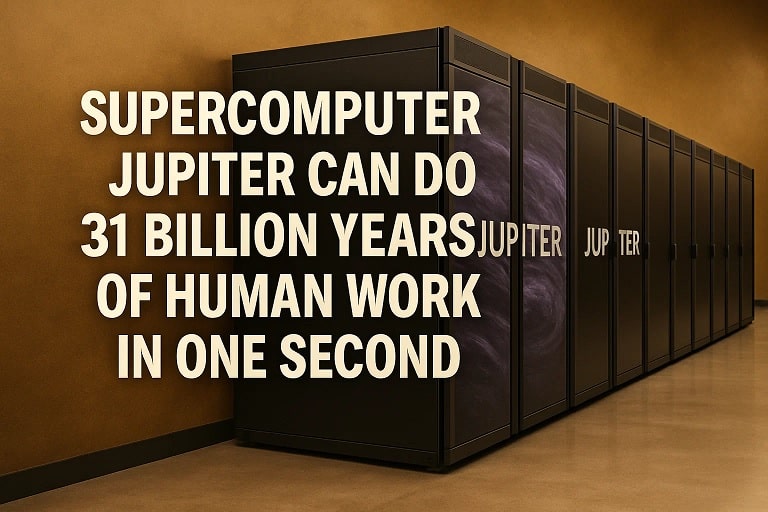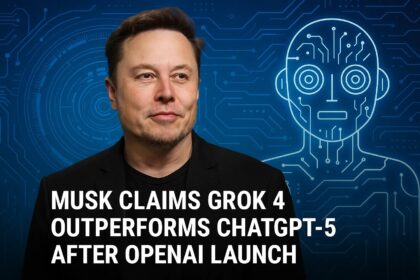Supercomputer JUPITER Can Perform a Quintillion Calculations Per Second: Redefining Computational Power
In June 2025, JUPITER, Europe’s first exascale supercomputer, was launched at Forschungszentrum Jülich in Germany, achieving a staggering 1 quintillion (10^18) floating-point operations per second (exaFLOP/s). Developed by the Jülich Supercomputing Centre (JSC) and the ParTec-Eviden consortium, JUPITER ranks as the world’s fourth-fastest and Europe’s most powerful supercomputer. Claims that it can perform “31 billion years of human work in one second” likely stem from speculative comparisons equating one exaFLOP to the human brain’s estimated processing power, though such analogies oversimplify complex neural computations. This article explores JUPITER’s capabilities, its drivers, historical context, future applications, and potential impacts, with a focus on how Tamil Nadu’s tech ecosystem could contribute to its global supply chain.
Why JUPITER Matters
JUPITER’s exascale performance enables breakthroughs in climate modeling, AI development, and medical research, addressing global challenges like sustainable energy and weather prediction. Its energy efficiency, at 60 gigaflops per watt, sets a new standard for supercomputing. For India, particularly Tamil Nadu’s Chennai and Coimbatore tech hubs, JUPITER’s reliance on advanced hardware offers opportunities to supply semiconductors and AI solutions, aligning with India Mobile Congress (IMC) 2025’s focus on tech innovation.
Latest Developments Driving JUPITER’s Launch
JUPITER’s debut on the June 2025 TOP500 list marks a milestone in high-performance computing (HPC). Key developments include:
- Exascale Performance: JUPITER achieves 1 exaFLOP/s at 64-bit precision for scientific simulations, and up to 70 exaFLOP/s at 8-bit precision for AI training, making it one of the world’s fastest AI supercomputers.
- Modular Design: Comprising a GPU-based Booster module (24,000 NVIDIA GH200 Grace Hopper Superchips) for compute-intensive tasks and a CPU-based Cluster module for data-intensive workloads, JUPITER is housed in a 2,300-square-meter Modular Data Centre (MDC).
- Energy Efficiency: With 60 gigaflops per watt, JUPITER is the most energy-efficient among the top five supercomputers, using waste heat to warm Jülich’s campus buildings.
- Early Access Success: The JUPITER Research and Early Access Program (JUREAP) tested applications like the Exascale Multiphysics Flows (ExaMFlow) project, simulating shock-droplet interactions for medical applications, achieving high efficiency on JUPITER’s JEDI and JETI modules.
- AI and Climate Applications: JUPITER supports high-resolution climate simulations (1 km resolution) and large language model (LLM) training, driving advancements in weather forecasting and AI research.
Tamil Nadu’s Context
Tamil Nadu’s semiconductor industry, including Chennai’s proposed chip fabrication units and Coimbatore’s IoT startups, can supply critical components like GPUs and cooling systems for supercomputers like JUPITER. The state’s expertise in AI, showcased at IMC 2025, positions it to contribute software solutions for JUPITER’s applications, fostering India-Germany tech collaboration.
Historical Context of Supercomputing
Supercomputing has evolved dramatically, with each decade marking a thousandfold increase in performance:
- 1993: The TOP500 list began, ranking supercomputers by FLOPS, with early systems in the gigaflop range.
- 2008: IBM’s Roadrunner broke the petaflop barrier (10^15 FLOPS), enabling complex simulations.
- 2022: Frontier at Oak Ridge National Laboratory became the first declared exascale supercomputer (1.1 exaFLOPS), followed by Aurora and El Capitan in the US.
- 2024: JUPITER’s JEDI module topped the Green500 list, achieving 72 gigaflops per watt, setting the stage for its exascale debut.
- 2025: JUPITER’s launch as Europe’s first exascale system, ranking fourth globally, marks a new era in HPC.
The “31 billion years of human work” claim likely derives from estimates comparing one exaFLOP to the human brain’s theoretical 1 exaFLOP processing power, suggesting JUPITER could simulate all human brain activity (10^33–10^36 operations) in seconds. However, such comparisons oversimplify the brain’s parallel, non-numerical processing.
Future Scopes and Projections
JUPITER’s capabilities could transform science and industry by 2030, with a projected $10 billion global HPC market impact. Key applications include:
- Climate Modeling: 1 km-resolution simulations for precise weather predictions, aiding Tamil Nadu’s monsoon-dependent agriculture.
- AI Development: Training LLMs 10x faster, with Tamil Nadu’s startups contributing algorithms.
- Medical Research: Simulating shockwave treatments for kidney stones, potentially involving Chennai’s biotech firms.
- Energy Systems: Optimizing sustainable grids, with Tamil Nadu supplying IoT sensors for monitoring.
Long-Term Strategic Outlook
By 2035, JUPITER could:
- Enhance Digital Twins: Support Earth Virtualization Engines, simulating climate at 1-meter resolution.
- Drive AI Innovation: Enable Tamil Nadu’s AI startups to develop open-source models via the Gauss AI Compute Competition.
- Boost Global Competitiveness: Contribute ₹2,000 crore to India’s tech exports through hardware and software.
- Challenges: High energy costs (€20 million annually), software optimization, and global supply chain constraints could limit scalability.
Impacts on the Indian Economy and Stakeholders
JUPITER’s global supply chain and applications create opportunities for India, particularly Tamil Nadu.
Sector-Wise Impacts
Technology and Semiconductors
- Impact: Demand for GPUs and cooling systems boosts Tamil Nadu’s semiconductor industry.
- Economic Contribution: ₹3,000 crore in exports, with Chennai at 50%.
- Business Opportunities: Firms like Tata Elxsi could supply chips for HPC.
AI and Software
- Impact: JUPITER’s AI training capabilities spur demand for Tamil Nadu’s AI algorithms.
- Economic Contribution: ₹1,000 crore in software exports by 2030.
- Business Opportunities: Coimbatore startups could develop climate modeling tools.
Agriculture and Climate
- Impact: Improved weather forecasts benefit Tamil Nadu’s 50 lakh farmers.
- Economic Contribution: ₹500 crore in agricultural savings.
- Business Opportunities: Chennai’s tech firms could integrate JUPITER’s data into forecasting apps.
Impact Snapshot
Sector | Project/Initiative | Tamil Nadu Impact |
|---|---|---|
Technology | GPU, Cooling Systems | ₹3,000 crore in semiconductor exports |
AI/Software | AI Model Training | Coimbatore AI algorithm development |
Agriculture/Climate | Climate Simulations | Thanjavur farming benefits |
Market Size (2030) | $10B (Global HPC) | ₹4,000 crore from Tamil Nadu |
Frequently Asked Questions (FAQs)
What can JUPITER do?
It performs 1 quintillion calculations per second (exaFLOP/s), enabling climate simulations, AI training, and medical research.
What does “31 billion years of human work” mean?
This claim likely misinterprets JUPITER’s exaFLOP equating to the human brain’s theoretical processing, but brain computations are not directly comparable.
How can Tamil Nadu contribute?
Its semiconductor and AI sectors can supply hardware and software, contributing ₹4,000 crore by 2030.
What are JUPITER’s applications?
It supports high-resolution climate models, AI model training, and medical simulations.
What challenges exist?
High energy costs, software optimization, and supply chain constraints could hinder scalability.












